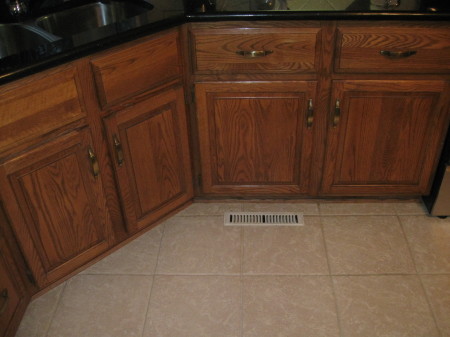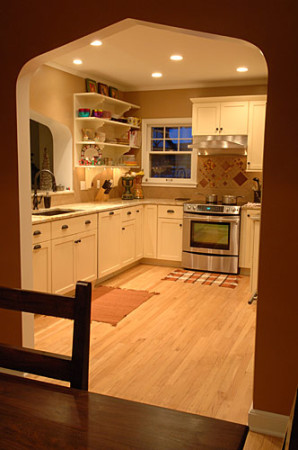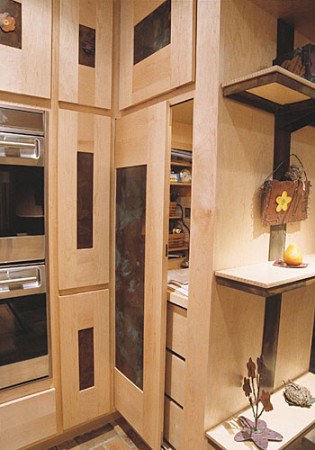Have you examined the cabinetry details in your kitchen or bathroom? What do you see when you look closely? We discussed what might encourage you to select custom cabinetry for your home in the prior post, Custom Cabinetry Solves Design Problems, highlighting general differences that aid design decisions.
Now, we explain three common cabinetry options below: stock, semi-custom, and custom.
Stock Cabinets

Many homeowners are familiar with the look of stock, oak cabinets. See how we transformed this West Des Moines kitchen.
Stock cabinets are just like they sound – in stock with very few options. What you see is what you get. The wood species and finishes are typically limited to two or three options, the doors & drawer fronts are usually held to a handful of styles, and the door hinges and drawer glides tend to be purely functional. Being the least expensive option in manufactured cabinetry, low cost materials like veneered particleboard are often used by manufacturers for the cabinet boxes, and the assembly process is especially automated. Cabinet sizes are typically limited to the most common widths and standard depths (12″ for wall cabinets and 24″ for base cabinets), and filler strips are required to close any gaps smaller 6″. Stock cabinets save money up front, however, their durability tends to be less than the other options.
Semi-Custom Cabinets

We updated this traditional Des Moines kitchen with semi-custom cabinets, which are available in a range of styles and colors.
This is the middle ground. Semi-custom cabinets introduce additional options for wood species and finishes, along with stylistic alternatives for door & drawer-fronts. Drawer boxes are usually built better, and options for drawer glides can be upgraded, par with fully custom hardware.
The spectrum of cabinet boxes vary from particle board to a more desirable 1/2″ or 5/8″ plywood, and shelving is commonly upgraded with more rigid plywood. Sizes remain standardized, but additional width and depths become available (15″ wall cabinets and 12″ base cabinets for example), and custom modifications can be integrated into some of the cabinet styles. Semi-custom options provide trim pieces that can be pre-finished to match new cabinets, generating a more custom look with manufactured parts. While the addition of more options and customization can be attractive at first glance, be aware that these modifications can quickly add cost, pushing semi-custom cabinets into the same price range, if not higher, than custom cabinetry without the added flexibility and refinement.
Custom Cabinets

In this Johnston kitchen remodel we built fully custom cabinets allowing us to hide a small workstation and mix different materials and finishes. The doors are maple and steel.
As we’ve said before, custom cabinetry can truly enhance your home and lifestyle. With custom cabinetry specialty woods or even locally sourced materials become available, and the ability to mix materials and finishes is introduced. The quality of construction should be top-notch; made from materials like solid wood, specialty veneers, and furniture grade plywood custom cabinetry is completed by skilled craftsmen. Soft-close doors and drawers become standard features, and unique hardware options, like push-to-open drawers, are available. Most importantly the cabinets are built specifically for your home, sometimes on site, to meet your needs and to fit in any location desired. The initial investment in custom cabinetry can be higher, but it is just that, an investment, one that has a long-standing return as they will work for you for many years to come.
Every home is unique and each project has different goals and priorities. We hope this discussion will help you make the most informed decision possible, or in the least, provide a starting place for further conversations about kitchen and bathroom design.